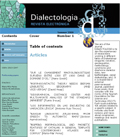Morphosyntactic theory needs iberian linguistic geography (and vice-versa)
Article Sidebar

Main Article Content
David Heap
Spanish clitic sequences, long thought to be strictly ordered, turn out to show variation in the order
of first and second person pronouns with the reflexive clitic se. This variation shows up in dialect data
spanning the 20th century, from the Atlas lingüístico de la Península Ibérica (www.alpi.ca) and other
linguistic atlas surveys as well as semi-directed interviews with older rural speakers from the Corpus oral y
sonoro del español rural. The analysis of nonstandard clitic sequences reveals an implicational asymmetry,
whereby nonstandard orders with first person singular me imply those with second person te but
nonstandard sequences with te can occur alone, without those involving me. Such a person asymmetry in
turn suggests that accounts of clitic ordering, whether they rely on templates, syntactic movement or ALIGN
constraints, must pay attention to the internal morphological structure of pronominal paradigms —
something we only notice if morphosyntactic analyses and geolinguistics mutually inform one another.
of first and second person pronouns with the reflexive clitic se. This variation shows up in dialect data
spanning the 20th century, from the Atlas lingüístico de la Península Ibérica (www.alpi.ca) and other
linguistic atlas surveys as well as semi-directed interviews with older rural speakers from the Corpus oral y
sonoro del español rural. The analysis of nonstandard clitic sequences reveals an implicational asymmetry,
whereby nonstandard orders with first person singular me imply those with second person te but
nonstandard sequences with te can occur alone, without those involving me. Such a person asymmetry in
turn suggests that accounts of clitic ordering, whether they rely on templates, syntactic movement or ALIGN
constraints, must pay attention to the internal morphological structure of pronominal paradigms —
something we only notice if morphosyntactic analyses and geolinguistics mutually inform one another.
Article Details
Cómo citar
Heap, David. «Morphosyntactic theory needs iberian linguistic geography (and vice-versa)». Dialectologia: revista electrònica, n.º 1, pp. 45-64, https://raco.cat/index.php/Dialectologia/article/view/198806.
Derechos
Derechos de autor
Dialectologia: revista electrònica està subjecta a una llicència Creative Commons 3.0 de Reconeixement - No Comercial - Sense Obres Derivades.Artículos más leídos del mismo autor/a
- Chitsuko Fukushima, David Heap, A report on the international conference: geolinguistics around the world , Dialectologia: revista electrònica: 2008: Núm.: 1
- David Heap, Diez años del ALPI (atlas lingüístico de la península ibérica) online , Dialectologia: revista electrònica: 2012: Special Issue III
- Pilar García Mouton, David Heap, Maria Pilar Perea, El presente y el futuro del Atlas Lingüístico de la Península Ibérica (ALPI) , Dialectologia: revista electrònica: 2012: Special Issue III